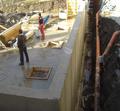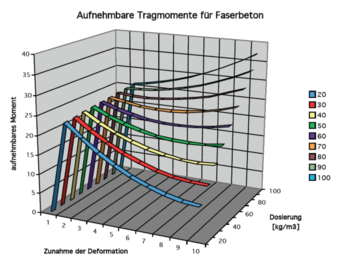Steel fiber concrete
Steel fiber reinforced concrete is a composite material consisting of the basic building material concrete supplemented with steel fibers . It is a homogeneous building material that can be loaded by pressure , tension and bending and can therefore be used for all types of construction and loads. Separate calculation methods ( dimensioning ) are used for dimensioning, depending on the type of load. The impairment caused by corrosion only plays a subordinate role with this composite building material.
history
Fibers in cement-bound building materials have been used for a long time. A calculation from a static point of view was not possible because there was no mechanical basis for it. It was not until the 1990s that various associations (such as the Association of German Steel Fiber Manufacturers) laid the foundations for use in the construction industry. Guidelines and dimensioning for foundation slabs followed, but there was still no broad application. With the leaflet “Steel fiber concrete” from the German Concrete and Construction Technology Association from October 2001, a general standard for the design, manufacture, processing and testing of steel fiber concrete was set for the first time in Germany. In 2008, Bernhard Wietek developed another design approach for steel fiber concrete. This made it possible to dimension components according to the occurring load effects.
Calculation rules for fiber concrete had existed in the GDR since 1988.
Current approaches to the design are based on probabilistic models of steel fiber concrete, in which the distribution and orientation of the steel fibers is described by random fields . Then, with the help of computer-aided simulation (for example, by Monte Carlo simulation ), conclusions can be drawn about the load-bearing behavior.
application
In general, steel fiber concrete can be used for almost all components of a building. The necessary dimensions are calculated, as is the economic efficiency. In contrast to reinforced concrete, steel fiber concrete is produced in one operation, which means that much less work is required during processing. This is a decisive economic advantage of steel fiber reinforced concrete as a building material.
The following pictures show a selection of such applications.
Shotcrete is an additional application for steel fiber concrete. Although there is a higher level of machine wear and tear, the additional work involved is compensated for by the simple, personnel-saving application. The following examples show some typical applications.
Components
The composite construction material steel fiber reinforced concrete essentially consists of concrete and the steel fibers. The steel fiber concrete is created by mixing the two parts. Both the individual building materials concrete and steel fiber are subject to great variation possibilities as well as the mixing ratio of these two ( called dosage ), it is decisive for the properties of the end product.
concrete
The properties of concrete and its designations are specified in national standards and also in the Eurocode . For a static analysis, concrete can be considered using the material laws of Christian Otto Mohr and Charles Augustin de Coulomb ( Mohr-Coulomb's criterion of fracture ). This creates the active stress area for materials , in which all stress states are permissible, stress states acting outside lead to failure of the material.
| Type of concrete | |||||
|---|---|---|---|---|---|
| C. | N / mm² | N / mm² | Degree | N / mm² | |
| 16/20 | 16 | 3.8 | 38.0 | 3.9 | 4.2 |
| 20/25 | 20th | 4.4 | 39.6 | 4.7 | 4.5 |
| 25/30 | 25th | 5.1 | 41.3 | 5.7 | 4.9 |
| 30/37 | 30th | 5.8 | 42.6 | 6.6 | 5.2 |
| 35/45 | 35 | 6.4 | 43.6 | 7.5 | 5.5 |
| 40/50 | 40 | 7.0 | 44.5 | 8.4 | 5.7 |
| 45/55 | 45 | 7.6 | 45.3 | 9.2 | 5.9 |
| 50/60 | 50 | 8.1 | 46.0 | 10.1 | 6.1 |
| 55/67 | 55 | 8.7 | 46.7 | 10.9 | 6.3 |
| 60/75 | 60 | 9.2 | 47.2 | 11.7 | 6.5 |
These characteristic values are now an output for the determination of the strength of the composite material steel fiber concrete.
Steel fiber
The number of types of steel fibers offered on the market is very large. In order to calculate components, however, the material strengths for the various fiber types in connection with concrete must be known in a verifiable manner. Therefore only a few fibers and their characteristics are listed. The characteristic values are determined in bending tests, whereby the influence of the steel fiber on the bending behavior is evaluated. This requires the investigation of concrete beams and steel fiber concrete beams under standardized test conditions.
With this series of tests, the characteristic values for the individual fibers are examined.
As a result, the following list can be given for the steel fibers already examined.
| designation | dimension | HE 55/35 | FE 65/35 |
|---|---|---|---|
| length | mm | 35 | 35 |
| diameter | mm | 0.55 | 0.65 |
| density | g / cm 3 | 7.88 | 7.88 |
| tensile strenght | N / mm² | 1000 | 1000 |
| Fiber angle 1 | Degree | 42 | 47 |
| Fiber angle 2 | Degree | 51 | 41 |
With these parameters and the corresponding dosage, the strength values of the respective steel fiber concrete can now be calculated using the Mohr-Coulomb relationships.
dosage
Dosage is the amount of steel fibers that are mixed into the concrete. The unit is given as kilograms per cubic meter (kg / m³).
Depending on the dosage, the influence of the steel fibers on the properties of the composite material can be controlled. In the calculation, the proportion of tensile strength due to the amount of steel fibers is determined via the fiber angle. With this tensile component, the respective tensile and compressive stress for this dosage can be determined in accordance with Mohr-Coulomb's law of substances. This results in a new representation in the stress circle and the permissible stress area. The dimensioning of a cross-section can now be carried out with these permissible stresses.
With increasing dosage, the load-bearing capacity is only moderately increased in the non-cracked state, on the other hand the influence is very significant with a partially or completely cracked cross-section (i.e. the steel fibers mainly hold the bending tension). It turns out that, in contrast to concrete, steel fiber concrete has post-cracking behavior that has a very positive effect.
Load-bearing behavior
For the dimensioning of components made of steel fiber concrete, there were general building inspectorate approvals from the German Institute for Structural Engineering in Berlin in 2010, for example, for the subject of approval, foundation plates made of steel fiber concrete . In this approval, the user has to work his way through 75 pages of dimensioning nomograms until he comes to a solution. The relatively complex procedure is only used by specialists.
There are also the design rules of the DBV data sheet. Another solution that can be used for all load conditions and building structures was developed by Wietek, which is presented below. In general, the design cross-section is divided into three different states:
The calculation can now be carried out according to the respective status. As a result of the variation of the crack depth and the dosage, the picture can be seen in the Dosage chapter.
Now the individual load cases can be calculated in the static calculation. These are:
- Bend
- Bending with longitudinal force
- Pressure - buckling
- Shear - shear force
- Breaking out of a support
Thus, the dimensions of the required cross-sections can be determined with relatively simple calculations. In general, it is advisable to work with a concrete quality as well as the dosage of a steel fiber in a building. This simplifies the static verifications considerably, because then only the cross-sectional values have to be calculated.
Calculation programs
FB-Bem or FC-calc
This Excel -based program was developed by the civil engineer Bernhard Wietek and is available in German (FB-Bem) and English (FC-calc) versions. The dimensioning of fiber concrete for the load cases bending, bending with longitudinal force, buckling, shear and punching is calculated here. All concrete grades can be reinforced with fibers made of steel, plastic or glass.
Preservation and durability
The preservation and durability of steel fiber concrete can be compared directly with that of concrete as a building material. The properties of the concrete are predominant so that no additional measures need to be taken. The only difference is in the corrosion of the steel fibers, which have to be considered separately.
corrosion
By carbonation or chloride penetration into concrete surfaces there is a risk of corrosion of the steel fibers. Corrosion results in an increase in volume from iron to iron oxides (or other corrosion compounds), which, however, is suppressed by the concrete. Since the steel fibers are usually less than a millimeter in cross-section, there are relatively small local forces that are usually absorbed by the concrete. Corrosion of the surrounding steel fibers is thus prevented by the concrete strength and there is no further spread in the component. Corrosion stains can develop on the surface that extend one to two millimeters into the component and that can be prevented with an appropriate surface treatment.
Regulations
There are currently no standards in Germany or Austria for steel fiber concrete. Since there are no technical building regulations introduced by the building authorities in Germany, the general use of steel fiber concrete in building construction and civil engineering is only possible with an individual approval from the supreme building authority of the respective federal state at the request of the building owner or with a general building authority approval.
The following regulations, among others, deal with steel fiber reinforced concrete:
- German Committee for Reinforced Concrete: Guideline "Steel fiber concrete", 2010
- SIA 162-6; SN 562162-6, February 1999, steel fiber concrete
- Information sheet steel fiber concrete of the DBV (German Concrete Association)
- Fiber concrete guideline of the ÖVBB (Austrian Association for Concrete and Construction Technology)
- General building inspectorate approvals from the German Institute for Building Technology in Berlin
See also
literature
- Bernhard Wietek: Steel fiber concrete. Basics and practical application. 2nd Edition. Vieweg + Teubner, Wiesbaden 2010, ISBN 978-3-8348-0872-1 .
- German Concrete and Construction Technology Association: DBV data sheet steel fiber concrete. October 2001.
Individual evidence
- ^ Association of German steel fiber manufacturers
- ↑ Bernhard Wietek: Steel fiber concrete. 2nd Edition. Vieweg + Teubner, Wiesbaden 2010, ISBN 978-3-8348-0872-1 .
- ↑ Erol Erdem: Probabilistic-based design of steel fiber-modified concrete components on an experimental basis. Ed .: Chair for solid construction at the Ruhr University Bochum. Bochum 2002.
- ↑ Markus Schadde: Reinforcement corrosion in steel fiber concrete. October 2007 (Arcelor seminar).
- ^ Deutsches Institut für Bautechnik (ed.): Directory of general building inspectorate approvals. Approval area: steel fiber concrete. March 29, 2010 (PDF).


















